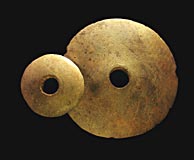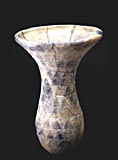The earliest inhabitants of the Sudan
The earliest traces of man on the Middle Nile region back 500,000
years - this is the dating of flint Acheulean handaxes. In the Late
Paleolithic period (c. 40,000 BP) the emergence of the first representatives
of
homo sapiens on the Blue Nile and the Atbara was accompanied
by small flint implements called microliths.
 The beginnings of pottery
The beginnings of pottery
About 9,000 BC (at the turn of the Pleistocene and the Holocene periods)
far-reaching climate changes took place, and as a result the central
part of the Sudan became part of the Sub-Saharan savannah zone. The
sustenance of small communities inhabiting partly permanent settlements
and seasonal camps consisted of an intensive adaptive economy: hunting,
fishing, and gathering fruit and wild grains. The sites of the Mesolithic
Early Khartoum culture (Saqqai, Khartoum Hospital ) yielded fragments
of the oldest clay vessels in all of Africa.
At the same time, in the region of the Second Cataract there appeared
hunters of the Arkin culture, who hunted the large mammals of the savannah,
and groups of people of the Qadan culture, who were based on fishing
and mollusk gathering and thus dependent on the ecosystem of river
valleys and the seasonally dry marshes.
First animal breeders
The second stage of late prehistory on the Middle Nile began at
the turn of the 6 th and 5 th millennia BC. Communities migrating from
the Western Desert spread the keeping of domesticated animals - oxen,
sheep and goats. These groups are jointly called the Khartoum Neolithic.
There is no convincing evidence for planned soil cultivation at this
time, or whether only wild species of millet and sorghum were consumed.
From the territory of the Central Sudan the rudiments of animal breeding
economy would spread both into the region of the Third Cataract and into
the heart of the African continent.
 Neolithic society
Neolithic society
The site of Kadero, ca 20 km north of Khartoum, has been investigated
by Poznań archaeologists for over 30 years. The Khartoum Neolithic
culture settlement and the nearby big cemetery offer a unique opportunity
to reconstruct various aspects of life of its shepherd community. During
excavations over 200 graves were unearthed, most of which contained
only humble equipment or none at all; a small percentage, however,
were burials of the elite concentrated at an isolated part of the cemetery.
The wealthier dead were provided with high-quality pottery (including
ritual vessels) and ornaments made of ivory, carnelian, rhyolite, malachite,
shells from the shores of the Red Sea and amazonite from the Sahara.
Clubs with stone heads were probably symbols o power.
Similar social differentiation is characteristic of the Late Neolithic
as well and can be observed, for example, at the cemetery from the first
half of the 4 th millennium BC in Kadada.

